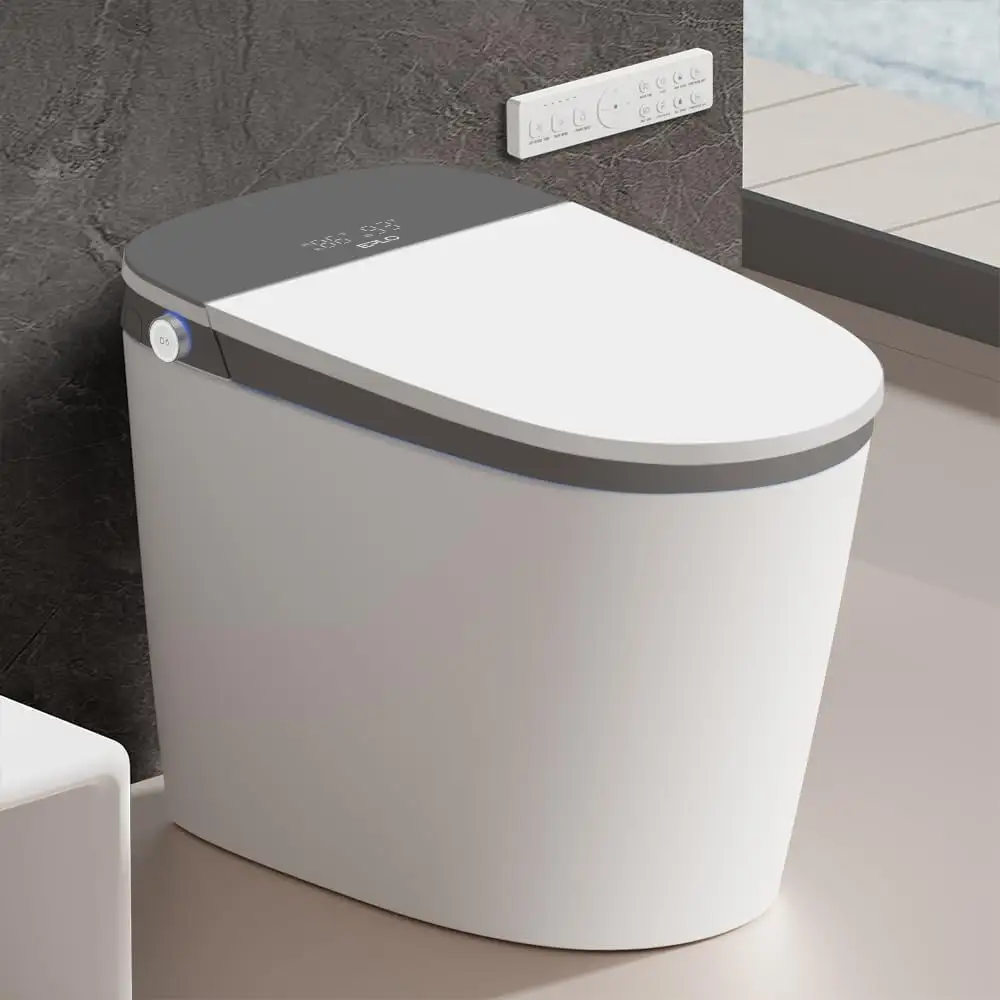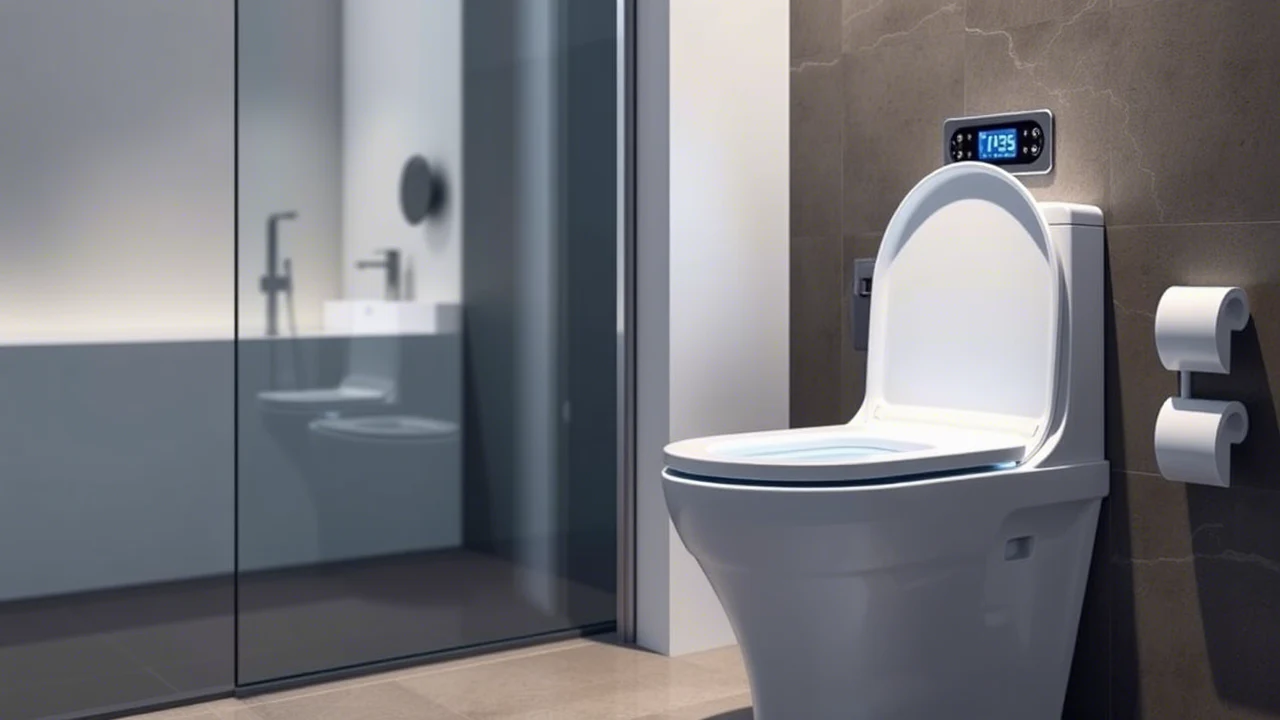In an era where our homes are becoming increasingly intelligent, even the most private spaces are receiving a high-tech makeover. The humble toilet, a fixture that has remained relatively unchanged for decades, is undergoing a revolutionary transformation.
Welcome to the world of smart toilets—where luxury meets hygiene, and technology enhances one of life’s most fundamental daily experiences.
Contents
Introduction to Smart Toilets
What is a Smart Toilet?
Picture this: You stumble into your bathroom at 3 AM, and the toilet lid automatically opens, greeting you with a gently illuminated bowl and a warm seat. This isn’t science fiction—it’s the reality of modern smart toilets.
At their core, smart toilets are sophisticated bathroom fixtures that combine traditional waste management functions with advanced technology to enhance comfort, hygiene, and overall user experience.
Evolution of Traditional Toilets to Smart Toilets
The journey from Thomas Crapper’s revolutionary flush toilet to today’s AI-powered thrones is nothing short of remarkable. While the basic principle remains unchanged, the integration of electronic bidet functions in the 1980s marked the beginning of toilet innovation.
Japanese manufacturers like TOTO led the charge, introducing their first electronic toilet seats in 1980. Today’s smart toilets represent the culmination of decades of technological advancement and user feedback.
Benefits of Smart Toilets in Modern Homes
Smart toilets aren’t just about luxury—they’re about reimagining bathroom hygiene for the 21st century. Beyond the obvious wow-factor, these high-tech fixtures offer tangible benefits that justify their increasingly popular adoption in modern homes:
- Enhanced hygiene through touchless operation
- Reduced water consumption despite improved cleaning performance
- Personalized comfort features that transform routine visits into spa-like experiences
- Health monitoring capabilities that can detect early signs of medical conditions
- Improved accessibility for elderly or mobility-impaired users
Core Smart Toilet Features
Hygiene and Cleaning Features
In a post-pandemic world, hygiene has taken center stage in home design. Smart toilets rise to the occasion with an arsenal of cleanliness features that would make a germaphobe smile.

Self-Cleaning Nozzles
Gone are the days of questionable bidet cleanliness. Modern smart toilets feature self-sterilizing nozzles that clean themselves before and after each use. These nozzles typically retract into a protected chamber when not in use, ensuring they remain pristine between sessions.
UV Sanitization
Some premium models employ UV light technology to eliminate 99.9% of bacteria and viruses. This invisible guardian works silently in the background, sanitizing the bowl surface continuously or between uses, depending on the model.
Anti-Bacterial Surfaces
Manufacturers have developed special glazes and coatings that make it difficult for bacteria to gain a foothold. TOTO’s CEFIONTECT glaze, for instance, creates an extraordinarily smooth surface where waste and bacteria quite literally can’t stick around.
Comfort and Convenience Features
Heated Seats
Nothing says “welcome” quite like a warm toilet seat on a cold winter morning. Smart toilets offer customizable seat heating, typically ranging from 28°C to 35°C (82°F to 95°F). Some models even remember your preferred temperature settings.
Temperature-Controlled Settings
Beyond seat heating, smart toilets offer temperature control for various functions:
- Water temperature for cleansing
- Air dryer temperature
- Ambient air deodorization
- Room heating (in premium models)
Soft-Close Lid
The satisfying whisper of a soft-closing toilet lid might seem like a small detail, but it’s these thoughtful touches that elevate the smart toilet experience. This feature prevents the jarring slam of traditional toilet lids and protects the mechanism from damage.
Water Efficiency Features
Dual Flush System
Modern smart toilets take water conservation seriously. Dual flush systems offer different water volumes for liquid and solid waste, typically using around 0.8 gallons for liquid waste and 1.28 gallons for solid waste—a significant improvement over traditional toilets’ 1.6-gallon standard.
Water-Saving Technology
Smart toilets employ various strategies to minimize water usage:
- Precision water jets that clean more effectively with less water
- Cyclone siphon flushing systems that maximize cleaning power
- Predictive flushing that adjusts water volume based on usage patterns
Adjustable Water Pressure
User comfort meets water efficiency with adjustable water pressure settings. Whether you prefer a gentle cleanse or a more vigorous wash, smart toilets let you customize the experience while maintaining water efficiency.
Advanced Technology in Smart Toilets
Automation and Touchless Features
Automatic Flush
Sensor-based flushing isn’t new, but smart toilets take it to the next level. Advanced models analyze usage patterns and adjust flush volume accordingly, ensuring optimal cleaning with minimal water waste.
Motion Sensor Activation
Proximity sensors detect approaching users and prepare the toilet for use by:
- Opening the lid automatically
- Activating seat heating
- Illuminating the bowl
- Starting air purification
Touchless Lid Opening and Closing
Wave your hand or foot near the designated sensor, and the lid responds accordingly. Some models even learn your preferences and adjust opening height based on whether you’re male or female.
Smart Connectivity Features
App Control and Customization
Modern smart toilets connect to smartphone apps that offer unprecedented control over your bathroom experience. Users can:
- Create and save personal profiles
- Monitor water and energy usage
- Schedule cleaning cycles
- Receive maintenance alerts
- Track health metrics
Bluetooth and Voice-Activated Controls
“Alexa, flush the toilet” might sound like a luxury too far, but voice control can be genuinely useful when your hands are occupied. Bluetooth connectivity enables wireless control through smartphone apps and integration with home automation systems.
Remote Control Functionality
Many smart toilets come with dedicated remote controls mounted on the wall or as portable units. These typically offer quick access to essential functions without requiring smartphone connectivity.
Health Monitoring Features
Built-In Health Sensors
Some high-end smart toilets incorporate sophisticated health monitoring capabilities:
- Urine analysis for glucose levels, protein content, and pH
- Weight and body fat measurements through the toilet seat
- Blood pressure monitoring
- Body temperature readings
Integration with Health Apps
Health data collected by smart toilets can be integrated with fitness apps and electronic health records, providing valuable insights into:
- Hydration levels
- Nutrition status
- Early disease markers
- Overall wellness trends
Luxury and Customization Options
Personalized User Experience
Adjustable Bidet Settings
Modern smart toilets offer unprecedented customization of cleaning functions:
- Water temperature (typically 30°C to 40°C)
- Spray patterns (oscillating, pulsating, or steady)
- Nozzle position adjustment
- Pressure control
Air Dryer with Adjustable Temperature
Built-in air dryers eliminate or reduce the need for toilet paper, offering:
- Multiple temperature settings
- Adjustable air flow patterns
- Timed drying cycles
Customizable User Profiles
Family members can create individual profiles storing their preferences for:
- Seat temperature
- Water temperature and pressure
- Air dryer settings
- Favorite cleaning cycles
Aesthetic and Design Features
Wall-Mounted Smart Toilets
Wall-mounted models offer several advantages:
- Modern, floating appearance
- Easier floor cleaning
- Space-saving design
- Adjustable height during installation
Compact Designs for Small Bathrooms
Manufacturers have developed space-efficient models that pack premium features into smaller footprints:
- Shortened projection from the wall
- Integrated bidet functionality without additional attachments
- Streamlined control panels
LED Night Lights for Ambiance
Smart toilets often feature programmable LED lighting that serves multiple purposes:
- Bowl illumination for nighttime use
- Mood lighting in various colors
- Status indicators for different functions
- Warning lights for maintenance needs
Eco-Friendly and Energy-Efficient Features
Energy-Efficient Operation
Smart toilets incorporate various energy-saving features:
- Instant water heating systems instead of storage tanks
- Motion-activated functions that operate only when needed
- Sleep modes during periods of inactivity
- LED lighting with minimal power consumption
Eco-Friendly Water Usage
Water conservation features include:
- High-efficiency flush systems using as little as 0.8 gallons per flush
- Greywater compatibility for appropriate models
- Smart sensors that prevent unnecessary flushing
- Water pressure optimization based on usage patterns
Sustainable Materials and Manufacturing
Leading manufacturers emphasize sustainability through:
- Recycled materials in construction
- Energy-efficient manufacturing processes
- Recyclable components
- Long-lasting designs that reduce replacement frequency
Maintenance and Durability Features
Self-Cleaning Toilets
Advanced self-maintenance features include:
- Automatic bowl rinsing between uses
- Self-sterilizing nozzles and surfaces
- Preventive cleaning cycles
- Built-in descaling programs
Easy-to-Replace Parts
Modern smart toilets are designed for serviceability:
- Modular components for simple replacement
- Tool-free access to common maintenance points
- Clear indicators for part replacement timing
- Available repair kits for common issues
Durable and Long-Lasting Materials
Quality smart toilets use premium materials:
- Vitreous china with specialized glazes
- Stainless steel nozzles and internal components
- Impact-resistant plastics for exterior parts
- Corrosion-resistant metals for fittings
Popular Smart Toilet Brands and Models
Overview of Leading Brands
TOTO
The Japanese pioneer of electronic toilets offers various models:
- NEOREST NX2 (flagship model with all premium features)
- WASHLET S550e (popular mid-range option)
- WASHLET C2 (entry-level smart toilet)
Kohler
American manufacturer known for innovation:
- Numi 2.0 (luxury smart toilet with voice control)
- Veil (wall-hung smart toilet with integrated cleansing)
- C3-230 (popular bidet seat with smart features)
DXV
Luxury brand offering sophisticated designs:
- SpaLet AT200 (integrated smart toilet)
- SpaLet AT100 (smart bidet seat)
Comparison of Top Models and Their Features
Premium Segment ($3,000+)
- TOTO NEOREST NX2
- Full automation
- ACTILIGHT cleaning system
- Premium materials and design
- Kohler Numi 2.0
- Voice control
- Ambient lighting
- Built-in speakers
Mid-Range ($1,000-$3,000)
- TOTO WASHLET S550e
- Most essential smart features
- Excellent value proposition
- DXV SpaLet AT200
- Good balance of features
- Stylish design
Entry-Level ($500-$1,000)
- TOTO WASHLET C2
- Basic smart features
- Reliable performance
- Kohler C3-230
- Good starter option
- Easy installation
Budget vs. Luxury Smart Toilets
When choosing between budget and luxury models, consider:
- Essential features vs. nice-to-have additions
- Installation requirements and costs
- Long-term maintenance expenses
- Available bathroom space
- Integration with existing home systems
Frequently Asked Questions (FAQs)
Are Smart Toilets Worth the Investment?
Smart toilets represent a significant initial investment, but their value proposition includes:
- Reduced water and toilet paper usage
- Enhanced hygiene and comfort
- Potential health monitoring benefits
- Increased home value
- Lower long-term maintenance costs
How Do Smart Toilets Save Water and Energy?
Smart toilets achieve efficiency through:
- Precision water usage in cleaning
- Optimized flush volumes
- Energy-efficient heating systems
- Motion-activated features
- Preventive maintenance alerts
What Maintenance is Required for Smart Toilets?
Regular maintenance typically includes:
- Periodic nozzle cleaning (usually automatic)
- Filter replacement (annually)
- Descaling in hard water areas
- Software updates when available
- Professional inspection every 2-3 years
Can Smart Toilets Be Installed in Any Bathroom?
Installation considerations include:
- Electrical outlet availability
- Water supply location
- Space requirements
- Floor strength (for heavy models)
- Local plumbing codes
Conclusion
Recap of Key Smart Toilet Features
Smart toilets represent the convergence of comfort, hygiene, and technology in the bathroom. Key features that define modern smart toilets include:
- Advanced cleaning and sanitization
- Automated convenience features
- Water and energy efficiency
- Health monitoring capabilities
- Customizable user experiences
The Future of Smart Toilets
The smart toilet industry continues to evolve with emerging technologies:
- AI-powered health monitoring
- Enhanced connectivity with smart home systems
- Improved sustainability features
- More affordable entry-level options
- Advanced waste analysis capabilities
Final Thoughts on Choosing the Right Smart Toilet
Selecting the perfect smart toilet requires careful consideration of:
- Your budget and desired features
- Bathroom space and layout
- Household needs and preferences
- Installation requirements
- Long-term maintenance commitment
In the end, a smart toilet is more than just a luxury bathroom fixture—it’s an investment in comfort, hygiene, and potentially even health monitoring. As technology continues to advance and prices become more accessible, smart toilets are poised to become standard features in modern homes, much like smartphones have become essential to our daily lives.


